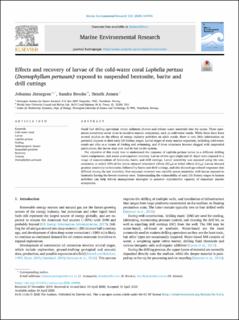| dc.contributor.author | Jarnegren, Johanna | |
| dc.contributor.author | Brooke, Sandra | |
| dc.contributor.author | Jensen, Henrik | |
| dc.contributor.author | | |
| dc.date.accessioned | 2020-05-15T08:00:07Z | |
| dc.date.available | 2020-05-15T08:00:07Z | |
| dc.date.created | 2020-05-04T09:40:52Z | |
| dc.date.issued | 2020 | |
| dc.identifier.issn | 0141-1136 | |
| dc.identifier.uri | https://hdl.handle.net/11250/2654566 | |
| dc.description.abstract | Fossil fuel drilling operations create sediment plumes and release waste materials into the ocean. These operations sometimes occur close to sensitive marine ecosystems, such as cold-water corals. While there have been several studies on the effects of energy industry activities on adult corals, there is very little information on potential impacts to their early life history stages. Larval stages of many marine organisms, including cold-water corals use cilia as a means of feeding and swimming, and if these structures become clogged with suspended particulates, the larvae may sink and be lost to the system. The objective of this study was to understand the response of Lophelia pertusa larvae to a different drilling waste components, and assess post-exposure recovery. Larvae of two ages (eight and 21 days) were exposed to a range of concentrations of bentonite, barite and drill cuttings. Larval sensitivity was assessed using the concentration at which 50% of the larvae showed behavioral effects (EC50) or lethal effects (LC50). Larvae showed greatest sensitivity to bentonite, followed by barite and drill cuttings, and also showed age-related responses that differed among the test materials. Post exposure recovery was variable across materials, with larvae exposed to bentonite having the lowest recovery rates. Understanding the vulnerability of early life history stages to human activities can help inform management strategies to preserve reproductive capacity of important marine ecosystems. | en_US |
| dc.language.iso | eng | en_US |
| dc.rights | Navngivelse 4.0 Internasjonal | * |
| dc.rights.uri | http://creativecommons.org/licenses/by/4.0/deed.no | * |
| dc.subject | Cold-water coral | en_US |
| dc.subject | Larvae | en_US |
| dc.subject | Lophelia pertusa | en_US |
| dc.subject | Drilling | en_US |
| dc.subject | Anthropogenic impact | en_US |
| dc.subject | Suspended particles | en_US |
| dc.subject | Recovery | en_US |
| dc.subject | Toxicity | en_US |
| dc.subject | Desmophyllum pertusum | en_US |
| dc.title | Effects and recovery of larvae of the cold-water coral Lophelia pertusa (Desmophyllum pertusum) exposed to suspended bentonite, barite and drill cuttings | en_US |
| dc.type | Peer reviewed | en_US |
| dc.type | Journal article | en_US |
| dc.description.version | publishedVersion | en_US |
| dc.rights.holder | ©2020TheAuthors | en_US |
| dc.subject.nsi | VDP::Matematikk og Naturvitenskap: 400::Zoologiske og botaniske fag: 480 | en_US |
| dc.source.volume | 158 | en_US |
| dc.source.journal | Marine Environmental Research | en_US |
| dc.identifier.doi | https://doi.org/10.1016/j.marenvres.2020.104996 | |
| dc.identifier.cristin | 1809161 | |
| cristin.ispublished | true | |
| cristin.fulltext | original | |
| cristin.fulltext | | |
| cristin.qualitycode | 2 | |

